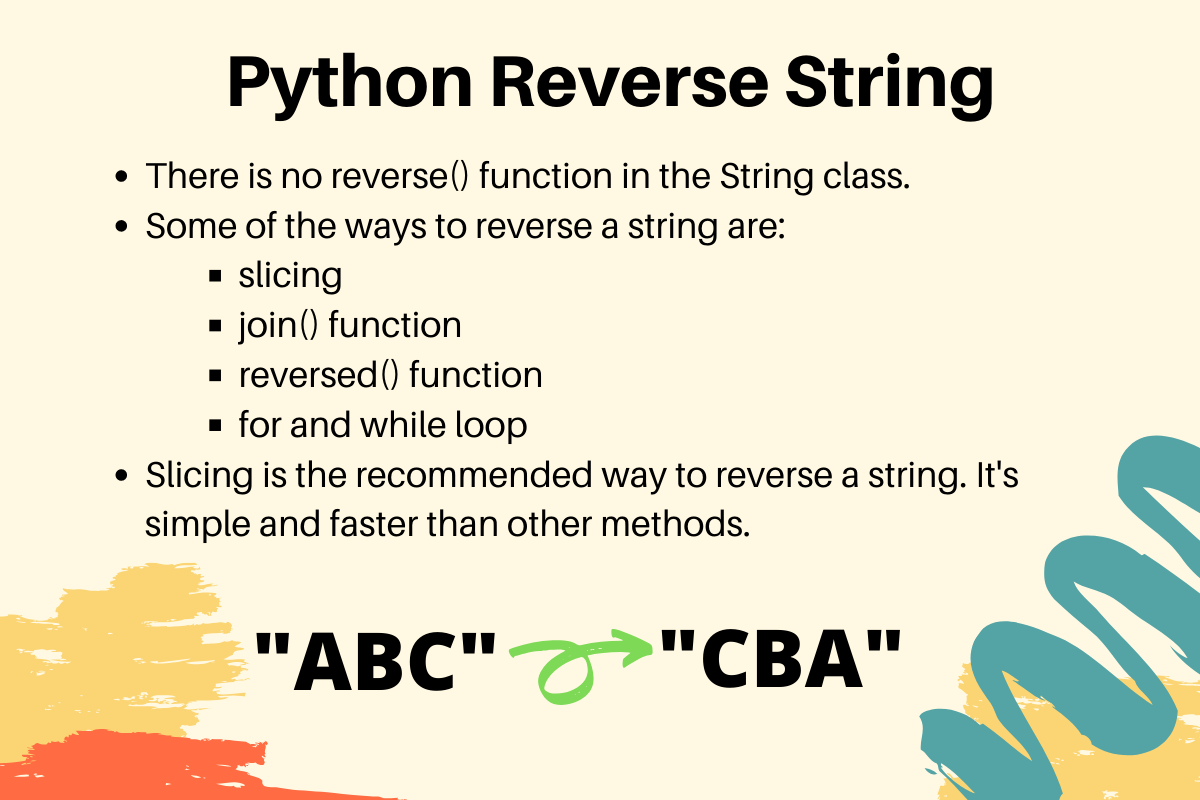String reversal is a common programming task that can be approached in multiple ways in Python. This comprehensive guide will explore various methods to reverse a string, discussing their pros, cons, and performance characteristics.
Why Reverse Strings?
String reversal has multiple use cases:
- Palindrome checking
- Text processing
- Algorithm challenges
- Data manipulation
- Cryptographic operations
1. Slice Notation Method (Most Pythonic)
def reverse_string_slice(s):
return s[::-1]
# Example usage
original = "hello world"
reversed_str = reverse_string_slice(original)
print(reversed_str) # Outputs: dlrow olleh
The slice notation [::-1] is the most concise and Pythonic way to reverse a string. The -1 step means traversing the string backwards.
2. Reversed() Function Method
def reverse_string_reversed(s):
return ''.join(reversed(s))
# Example usage
original = "hello world"
reversed_str = reverse_string_reversed(original)
print(reversed_str) # Outputs: dlrow olleh
The reversed() function returns a reverse iterator which can be joined back into a string.
3. Manual Reversal with a Loop
def reverse_string_loop(s):
reversed_str = ""
for char in s:
reversed_str = char + reversed_str
return reversed_str
# Example usage
original = "hello world"
reversed_str = reverse_string_loop(original)
print(reversed_str) # Outputs: dlrow olleh
This method manually builds the reversed string by prepending each character.
4. Recursive Approach
def reverse_string_recursive(s):
if len(s) <= 1:
return s
return reverse_string_recursive(s[1:]) + s[0]
# Example usage
original = "hello world"
reversed_str = reverse_string_recursive(original)
print(reversed_str) # Outputs: dlrow olleh
A recursive method that breaks down the string and rebuilds it in reverse order.
Performance Comparison
import timeit
def slice_method(s):
return s[::-1]
def reversed_method(s):
return ''.join(reversed(s))
def loop_method(s):
reversed_str = ""
for char in s:
reversed_str = char + reversed_str
return reversed_str
def recursive_method(s):
if len(s) <= 1:
return s
return recursive_method(s[1:]) + s[0]
# Test string
test_string = "hello world" * 100
# Performance timing
print("Slice Method:",
timeit.timeit(lambda: slice_method(test_string), number=10000))
print("Reversed Method:",
timeit.timeit(lambda: reversed_method(test_string), number=10000))
print("Loop Method:",
timeit.timeit(lambda: loop_method(test_string), number=10000))
print("Recursive Method:",
timeit.timeit(lambda: recursive_method(test_string), number=10000))
Demonstrates performance differences between reversal methods.
Advanced String Reversal Techniques
Reversing Unicode and Emoji Strings
def reverse_unicode_string(s):
return ''.join(reversed(list(s)))
# Unicode and emoji support
unicode_str = "Hello 🌍! こんにちは"
print(reverse_unicode_string(unicode_str))
Shows how to handle complex Unicode and emoji strings.
Practical Applications
1. Palindrome Checker
def is_palindrome(s):
# Remove spaces and convert to lowercase
clean_s = ''.join(char.lower() for char in s if char.isalnum())
return clean_s == clean_s[::-1]
# Examples
print(is_palindrome("A man, a plan, a canal: Panama")) # True
print(is_palindrome("race a car")) # False
Demonstrates a real-world application of string reversal in palindrome detection.
2. Word Reversal
def reverse_words(sentence):
return ' '.join(sentence.split()[::-1])
original = "Python is awesome"
print(reverse_words(original)) # Outputs: awesome is Python
Shows how to reverse the order of words in a sentence.
Best Practices and Considerations
- Performance: For short strings, all methods are comparable
- Readability: Slice notation
[::-1]is most Pythonic - Memory Efficiency: Slice method creates a new string
- Unicode Handling: Use
reversed()or careful slicing for complex strings
Common Pitfalls
- Recursion can cause stack overflow for very long strings
- Some methods are less memory-efficient
- Unicode strings require careful handling
Type Hints and Implementation
def robust_reverse(s: str) -> str:
"""
Safely reverse a string with type checking
Args:
s (str): Input string to reverse
Returns:
str: Reversed string
"""
if not isinstance(s, str):
raise TypeError("Input must be a string")
return s[::-1]
Demonstrates type hinting and input validation.
String reversal in Python offers multiple approaches, each with unique characteristics. The slice notation [::-1] remains the most Pythonic and efficient method for most use cases.
Key Takeaways
- Multiple string reversal techniques exist
- Slice notation is most recommended
- Consider performance and readability
- Handle Unicode carefully
- Understand the specific requirements of your use case
Similar Articles
https://www.geeksforgeeks.org/reverse-string-python-5-different-ways/
https://www.digitalocean.com/community/tutorials/python-reverse-string
More Articles from Python Central

